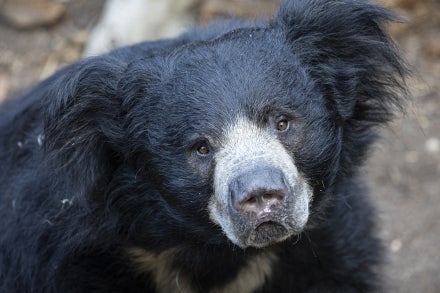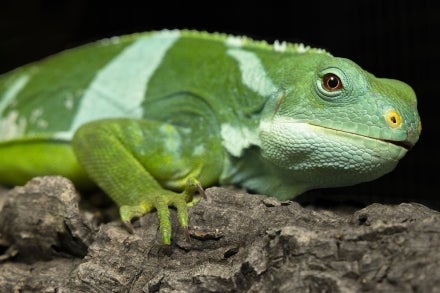
Across a cold, desolate stretch of the Arctic, two tiny polar bear cubs huddle, alone and unprotected, their cries carrying on the biting wind. Their mother, the heart of their world, was lost to the unforgiving challenges polar bears face across this landscape. Hungry and vulnerable, the cubs’ chances of survival were bleak without a mother to protect them and teach them how to hunt for their main food source, seals.
Fortunately, their story didn’t end there. The little ones’ mother was being monitored as part of a conservation program, and teams worked tirelessly to locate and rescue the orphaned cubs when they learned of her passing. As a global nonprofit conservation organization, we partner with organizations around the world to protect their species and we’ve cared for polar bears since 1917. U.S. Fish and Wildlife chose the San Diego Zoo to rehabilitate and care for the pair, now called Kalluk and Tatqiq, along with another orphan named Chinook, and to be their forever home.
Here, with expert teams of veterinarians, nutritionists, behaviorists, biologists, and conservation scientists, as well as more than a century of polar bear care experience, all three bears have found safety, nourishment, and a new home where they have been able to thrive against all odds. Each soft pawstep they take today is a poignant reminder of the fragility of their species and the critical importance of protecting our planet’s wildlife.

Polar bear moms teach their young essential survival skills, including hunting.
Raising Orphans
Without mothers to nurture them or teach them essential survival skills, the three rescued polar bear orphans, Tatqiq, Kalluk, and Chinook, could not be reintroduced into their native habitat. Now in their 20s, the bears have been cared for at the San Diego Zoo for decades, becoming incredible ambassadors for their species. Each year, they inspire countless wildlife allies while contributing to conservationists' understanding of polar bears' needs amidst a rapidly changing Arctic environment. Our expert teams collaborate with global partners on these vital conservation initiatives to help ensure a future for polar bears in native habitats.

Orphaned polar bear cubs are thriving with the expert care of veterinarians, nutritionists, behaviorists, biologists, and conservation scientists, as well as more than a century of polar bear care experience.
At the Zoo’s Conrad Prebys Polar Bear Plunge, the bears thrive in the summer version of their native tundra ecosystem. Surprisingly, summer temperatures in the Arctic can climb into the high 70s. So in their dynamic environment here, our expert nutritionists create a healthy and balanced diet to ensure optimal body condition. This is different than polar bears needing an extra thick layer of blubber necessary to survive frozen Arctic winters.
Even so, the polar bears choose where they spend their time, with temperature-controlled climates including frigid areas of their habitats, daily snow, and an chilled aquatic environment. Wildlife care teams note, however, that if the water gets too chilly, they won’t go in! Instead, the bears often choose to forego the many cold options they have in order to lounge in the sun. This preference reflects natural behaviors, as polar bears comfortably adjust to varied climates, including that of summer on the tundra.

The bear trio experiences a variety of chilly experiences to choose from every day.
One of a Kind
Polar bears, with their unmistakable white coats, are unique in more ways than one. As Earth’s largest bear, they can weigh up to 1,600 pounds and reach an astounding 12 feet in height when standing on their hind legs. They’re so interconnected to their unique sea ice ocean ecosystems that their scientific name ursus maritimus means “sea bear”.
While Tatqiq, Kalluk, and Chinook are fortunately safe and thriving, polar bears across the Arctic face significant challenges that continue to threaten the future of their species. Classified as Vulnerable to extinction, their survival is increasingly at risk due to rising temperatures brought on by climate instability. The Arctic is currently warming twice as fast as the rest of the planet, drastically reducing the sea ice polar bears rely on to hunt, mate, and raise their young.
As the ice disappears, bears are forced to travel longer distances in search of food, often leading to malnutrition and reduced reproductive success. Human activities exacerbate the issue, contributing to habitat degradation and environmental contamination. The increasing interaction between polar bears and human populations can also create conflict as bears are forced to seek out alternate food sources, further jeopardizing their safety. Addressing these challenges is crucial to ensuring long-term sustainable populations of the species, which is the work we do through our Oceans Conservation Hub.

Innovative technology, including Mini DenCam cameras, is providing new insights as mother polar bears emerge from dens with their cubs. Some of these technologies are perfected with the help of polar bears at the San Diego Zoo.
Securing the Future
Kalluk, Tatqiq, and Chinook not only found a second chance at the Zoo—they’re helping give their species a second chance, too. Through innovative conservation science, the bears have contributed to the understanding of polar bear energetics and hearing sensitivity, which informs strategies to protect them in native habitat. Studies of their hearing range have informed guidelines to mitigate human-made noise disruptions near critical denning sites in the Arctic, while other efforts have provided crucial data for evaluating how polar bears adapt to a changing climate marked by reduced sea ice.
The bears are also able to try out new noninvasive conservation tracking methods before they’re used to help bears in the Arctic, including "Burr on Fur". This lightweight, non-invasive tracking device attaches to a polar bear's fur, almost like a barrette. It’s intended to provide researchers with critical data without disrupting the animal's natural behavior, including movement patterns, hunting, and habitat use, all of which are essential for understanding how polar bears adapt to rapidly changing environmental conditions, including improving coexistence techniques for communities living near polar bear habitats. Conservationists are able to perfect the use of noninvasive methods like this with a little help from the bear trio at the Zoo.

Interestingly, the Arctic experiences seasons and can reach temps into the high 70s in the summer.
Winter, Spring, Summer, and Fall
Just as the Arctic undergoes seasonal changes, so too do polar bears. If you follow along closely, whether in person at the Zoo or through Polar Bear Cam, you might notice various behaviors at different times. For example, during breeding season, male polar bears like Kalluk have one thing on their minds: impressing the ladies. You may see him paying more attention to Chinook, the bear who is not his sister, than to eating, and that’s completely normal. Food takes a backseat during this time, but his care team is always there to ensure he stays healthy and strong, even when his behavior might seem unusual. And if you notice him salivating a bit more, that’s just part of the effort he puts in. Male polar bears naturally burn more energy and eat less during this time, so he might look a bit slimmer—all natural parts of the process.

As a global nonprofit conservation organization, we work with partners to secure the future for vulnerable species including polar bears.
Hope on the Horizon
Tatqiq, Chinook, and Kalluk are no longer the shivering, vulnerable, tiny cubs they were when they were orphaned in the Arctic. Today, they continue to thrive at the Zoo, reminding us all of the resilience and hope that is possible when people come together to make a difference.
When you visit them, you not only witness their extraordinary care and dynamic natural behaviors but also contribute directly to conservation initiatives aimed at saving, protecting, and caring for the species. As a nonprofit organization, each visit supports our global conservation efforts, including through our Oceans Conservation Hub. Together with our partners, we’re committed to making an impact for all polar bear families that need us, wherever they are—now, and for generations to come.
Photo credits: Top Photo ea-4/iStock/Getty Images Plus; Dencam photo: Kt Miller/Polar Bears International; Last Photo; mlharing/iStock/Getty Images Plus




